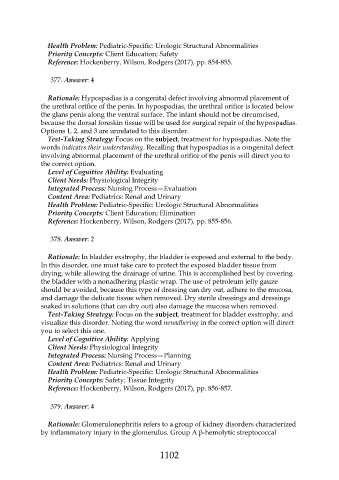Page 1102 - Saunders Comprehensive Review For NCLEX-RN
P. 1102
Health Problem: Pediatric-Specific: Urologic Structural Abnormalities
Priority Concepts: Client Education; Safety
Reference: Hockenberry, Wilson, Rodgers (2017), pp. 854-855.
377. Answer: 4
Rationale: Hypospadias is a congenital defect involving abnormal placement of
the urethral orifice of the penis. In hypospadias, the urethral orifice is located below
the glans penis along the ventral surface. The infant should not be circumcised,
because the dorsal foreskin tissue will be used for surgical repair of the hypospadias.
Options 1, 2, and 3 are unrelated to this disorder.
Test-Taking Strategy: Focus on the subject, treatment for hypospadias. Note the
words indicates their understanding. Recalling that hypospadias is a congenital defect
involving abnormal placement of the urethral orifice of the penis will direct you to
the correct option.
Level of Cognitive Ability: Evaluating
Client Needs: Physiological Integrity
Integrated Process: Nursing Process—Evaluation
Content Area: Pediatrics: Renal and Urinary
Health Problem: Pediatric-Specific: Urologic Structural Abnormalities
Priority Concepts: Client Education; Elimination
Reference: Hockenberry, Wilson, Rodgers (2017), pp. 855-856.
378. Answer: 2
Rationale: In bladder exstrophy, the bladder is exposed and external to the body.
In this disorder, one must take care to protect the exposed bladder tissue from
drying, while allowing the drainage of urine. This is accomplished best by covering
the bladder with a nonadhering plastic wrap. The use of petroleum jelly gauze
should be avoided, because this type of dressing can dry out, adhere to the mucosa,
and damage the delicate tissue when removed. Dry sterile dressings and dressings
soaked in solutions (that can dry out) also damage the mucosa when removed.
Test-Taking Strategy: Focus on the subject, treatment for bladder exstrophy, and
visualize this disorder. Noting the word nonadhering in the correct option will direct
you to select this one.
Level of Cognitive Ability: Applying
Client Needs: Physiological Integrity
Integrated Process: Nursing Process—Planning
Content Area: Pediatrics: Renal and Urinary
Health Problem: Pediatric-Specific: Urologic Structural Abnormalities
Priority Concepts: Safety; Tissue Integrity
Reference: Hockenberry, Wilson, Rodgers (2017), pp. 856-857.
379. Answer: 4
Rationale: Glomerulonephritis refers to a group of kidney disorders characterized
by inflammatory injury in the glomerulus. Group A β-hemolytic streptococcal
1102

